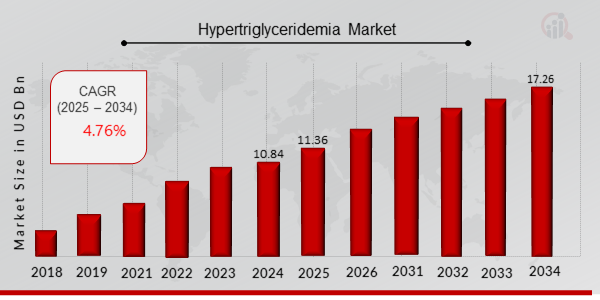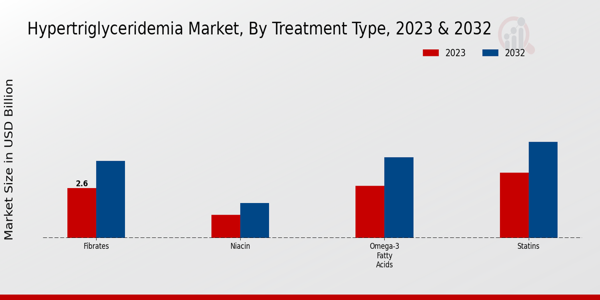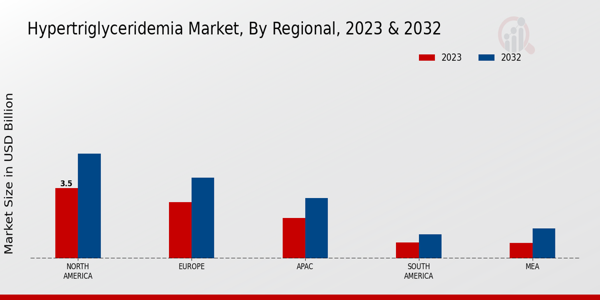Hypertriglyceridemia Market Overview
As per MRFR analysis, the Hypertriglyceridemia Market Size was estimated at 10.84 (USD Billion) in 2024. The Hypertriglyceridemia Market Industry is expected to grow from 11.36 (USD Billion) in 2025 to 17.26 (USD Billion) till 2034, at a CAGR (growth rate) is expected to be around 4.76% during the forecast period (2025 - 2034).
Key Hypertriglyceridemia Market Trends Highlighted
The Hypertriglyceridemia Market is experiencing significant dynamics driven by increasing awareness of cardiovascular diseases and the crucial role triglycerides play in these conditions. The rise in obesity rates and unhealthy lifestyles has led to a growing number of individuals diagnosed with hypertriglyceridemia, fostering demand for effective treatment options.
Pharmaceutical advancements and innovative therapies are also propelling market growth as health professionals seek more efficient solutions to lower triglyceride levels and improve patient outcomes. Furthermore, the aging population, often experiencing metabolic disorders, is contributing to a rise in demand for hypertriglyceridemia treatments.Opportunities in this market remain vast, particularly in leveraging digital health technologies and telemedicine to enhance patient engagement and compliance.
There is also potential for growth in personalized medicine approaches that tailor treatments based on individual patient profiles. Additionally, companies that focus on developing novel drug formulations with fewer side effects can capture an increasingly health-conscious demographic. Collaborative efforts among pharmaceutical companies, research institutions, and healthcare providers can foster innovation and speed up the drug development process, ultimately benefiting patients. Recent trends indicate a steady shift toward preventive care, with a focus on lifestyle modifications alongside medical treatments.The introduction of nutraceuticals and dietary supplements that target triglyceride reduction is gaining traction.
Digital health applications that monitor triglyceride levels and provide dietary suggestions are becoming more prevalent. These trends reflect a holistic approach to managing hypertriglyceridemia, emphasizing the need for continuous education and awareness. As the market evolves, stakeholders need to remain adaptive to these changes while pursuing new avenues for growth and development in the hypertriglyceridemia space, ensuring better health outcomes for individuals at risk.

Source: Primary Research, Secondary Research, MRFR Database and Analyst Review
Hypertriglyceridemia Market Drivers
Increasing Prevalence of Hypertriglyceridemia
The rising prevalence of hypertriglyceridemia across various demographics is a significant driver of growth in the Hypertriglyceridemia Market Industry. With lifestyle changes, unhealthy eating habits, and sedentary lifestyles becoming more common, the incidence of high triglyceride levels is on the rise. This has been compounded by an increase in obesity rates, changes in dietary patterns – particularly the consumption of high-calorie and processed foods – as well as genetic predispositions to lipid disorders.
The World Health Organization has noted a troubling increase in metabolic syndrome and related disorders, where hypertriglyceridemia is often a key component. As the awareness regarding the long-term health risks associated with high triglycerides, such as cardiovascular diseases and pancreatitis, becomes more prevalent, there is a growing focus on screening, diagnosis, and treatment. With more patients being diagnosed, there is an increasing demand for effective therapeutic options, thus fueling the Hypertriglyceridemia Market.
In addition, advancements in diagnostic technologies are enabling early detection and management of hypertriglyceridemia, further facilitating patient access to necessary treatments. Overall, the increasing prevalence of hypertriglyceridemia underscores the urgency for medical providers and industries alike to develop innovative solutions and interventions tailored to meet the needs of affected populations.
Technological Advancements in Treatment
Ongoing technological advancements in treatment modalities contribute significantly to the Expansion of the Hypertriglyceridemia Market Industry. New and improved drugs, including novel lipid-lowering agents, are being developed and introduced into the market, which enhances therapeutic options for patients with elevated triglyceride levels. Innovations in drug delivery systems, personalized medicine approaches, and combination therapies are driving effectiveness while also improving patient adherence to treatment regimens.As the pipeline for potential therapies grows, the market is becoming increasingly competitive, thus providing opportunities for both established players and new entrants to cater to diverse consumer demands.
Rising Awareness and Preventive Healthcare
Growing awareness about the importance of managing triglyceride levels is propelling the Hypertriglyceridemia Market Industry forward. As healthcare providers, organizations, and educational institutions ramp up initiatives to inform the public about the risks associated with hypertriglyceridemia, more individuals are seeking testing and preventative measures. This trend is increasingly supported by health campaigns promoting lifestyle modifications, such as improved diet, regular exercise, and routine health checks.The correlation between triglyceride levels and serious health issues, such as heart disease, emphasizes the need for proactive healthcare strategies. This heightened focus on preventive healthcare not only helps in the early identification and management of hypertriglyceridemia but also drives demand for related products and services in the market.
Hypertriglyceridemia Market Segment Insights
Hypertriglyceridemia Market Treatment Type Insights
The Hypertriglyceridemia Market is segmented by Treatment Type, which plays a crucial role in addressing elevated triglyceride levels in patients. As of 2023, this market is valued at 9.88 billion USD, with projections indicating growth over the coming years due to the rising awareness of hypertriglyceridemia and its associated health risks.
Among the various treatment types, Fibrates represent a significant segment, valued at 2.6 billion USD in 2023 and expected to reach 4.0 billion USD in 2032, due to their effectiveness in reducing triglyceride levels while simultaneously increasing high-density lipoprotein (HDL) cholesterol.Statins also dominate the market with a valuation of 3.38 billion USD in 2023, reflecting widespread use in the management of cholesterol and triglyceride levels, thereby underscoring their pivotal role in cardiovascular health management.
Omega-3 Fatty Acids stand as another important segment, with a market valuation of 2.7 billion USD anticipated for 2023, driven by their anti-inflammatory properties and cardioprotective effects, further reinforcing their significance against hypertriglyceridemia. Meanwhile, Niacin, valued at 1.2 billion USD in 2023, represents a less dominant segment compared to the others but continues to be a valuable option due to its ability to increase HDL cholesterol while lowering LDL cholesterol.
As the Hypertriglyceridemia Market progresses, advancements in research and development for these treatment types reflect a growing emphasis on personalized medicine, paving the way for new opportunities and solutions to manage hypertriglyceridemia effectively. The rising prevalence of metabolic disorders, increased healthcare expenditure, and the aging population act as strong growth drivers for these treatment types. However, challenges such as side effects associated with some treatments and the availability of alternative therapies maintain a looming presence, impacting their market potential.
Overall, the market dynamics exposed within the Treatment Type segment suggest a strong influence on the Hypertriglyceridemia Market revenue, indicating favorable conditions for growth and innovation in therapeutic options designed to combat elevated triglyceride levels effectively.

Source: Primary Research, Secondary Research, MRFR Database and Analyst Review
Hypertriglyceridemia Market Route of Administration Insights
The Hypertriglyceridemia Market is poised for growth, with a projected valuation of 9.88 USD Billion in 2023. The Route of Administration plays a significant role in this market, encompassing various modalities that aid in the effective treatment of hypertriglyceridemia.
Among these, the Oral route is often the most preferred due to its ease of use and convenience for patients, thereby facilitating adherence to therapy. The Intravenous route serves critical cases requiring swift intervention, while the Subcutaneous route has been gaining traction owing to advancements in delivery systems, such as injectables that enhance patient compliance.Each of these routes contributes uniquely to the overall landscape of Hypertriglyceridemia Market revenue, addressing different patient needs and preferences.
As the industry continues to evolve, market growth is driven by the increased prevalence of hypertriglyceridemia globally, advancements in drug formulations, and the demand for patient-centric treatment options. However, challenges, such as the high cost of new therapies and potential side effects associated with certain administration methods, linger. Yet, opportunities in the form of innovative drug delivery solutions and expanding healthcare access are expected to further propel the Hypertriglyceridemia Market statistics in the coming years.
Hypertriglyceridemia Market Distribution Channel Insights
The Distribution Channel segment of the Hypertriglyceridemia Market plays a crucial role in delivering medications effectively to patients suffering from this condition. In 2023, the market is valued at approximately 9.88 USD Billion, showcasing the importance of efficient distribution methods in ensuring medication accessibility.
The segment is divided into Hospital Pharmacies, Retail Pharmacies, and Online Pharmacies, each contributing uniquely to market dynamics. Hospital Pharmacies often dominate due to their direct access to patients and the ability to provide specialized pharmacological care.Retail Pharmacies remain significant, as they facilitate convenient access to medications for everyday consumers. Meanwhile, Online Pharmacies have gained traction, particularly due to increasing digitalization and the preference for home delivery options.
The growth of each distribution channel reflects broader market trends, such as the rising prevalence of hypertriglyceridemia and the growing need for accessible treatment options. Furthermore, the Hypertriglyceridemia Market Statistics indicate rising consumer awareness, creating overall opportunities for enhanced distribution methodologies.These channels collectively enhance the Hypertriglyceridemia Market revenue by improving accessibility and consumer engagement in a continually evolving industry landscape.
Hypertriglyceridemia Market Patient Type Insights
The Hypertriglyceridemia Market, which was valued at 9.88 USD Billion in 2023, shows a steady potential for growth through its diversification into various Patient Types. This market segmentation includes Adults, Pediatrics, and Geriatrics, each playing a crucial role in the overall market landscape. Adults represent a major portion due to the increasing prevalence of lifestyle-related conditions such as obesity and diabetes, driving demand for treatments. The Pediatric segment demonstrates significant potential, as awareness about childhood obesity and triglyceride levels rises, presenting new opportunities for market players.
Geriatric patients are also important as age-related metabolic changes contribute to elevated triglyceride levels, leading to increased healthcare needs. The interplay of these groups emphasizes the need for targeted interventions, reflecting the Hypertriglyceridemia Market statistics and trends focused on better management and therapy solutions across diverse age demographics. Opportunities abound for developing personalized treatment plans, while challenges arise from varying treatment responses in different age categories, highlighting the importance of tailored approaches in this industry.
Hypertriglyceridemia Market Regional Insights
The Hypertriglyceridemia Market is experiencing notable growth, with a significant emphasis on its regional dynamics. In 2023, North America holds the largest market share, valued at 3.5 USD Billion, and is expected to expand to 5.2 USD Billion by 2032, reflecting its prominent position in the industry. Europe follows closely, with a market valuation of 2.8 USD Billion in 2023, rising to 4.0 USD Billion, showcasing its substantial role.
APAC is also emerging strongly, valued at 2.0 USD Billion in 2023 and projected to reach 3.0 USD Billion, indicating its growing demand driven by increased awareness of hypertriglyceridemia.Meanwhile, South America and MEA are smaller markets, valued at 0.8 USD Billion and 0.78 USD Billion in 2023, respectively; however, they demonstrate potential for growth, with projected valuations of 1.2 USD Billion and 1.5 USD Billion by 2032.
The dominance of North America highlights its advancement in healthcare infrastructure and robust research activities. The trends in treatment options, growing population awareness, and lifestyle changes are pivotal drivers of growth across all regions, creating increased opportunities in the Hypertriglyceridemia Market revenue landscape.

Source: Primary Research, Secondary Research, MRFR Database and Analyst Review
Hypertriglyceridemia Market Key Players and Competitive Insights
The Hypertriglyceridemia Market is characterized by a growing recognition of the health implications associated with elevated triglyceride levels, which can lead to severe cardiovascular diseases. As awareness increases, numerous pharmaceutical companies strive to develop innovative therapies and treatment options to cater to this expanding need. Competitive insights in this market reveal that various strategies are being employed, including extensive research and development activities, collaborations, mergers, and acquisitions, which are pivotal in enhancing product portfolios and gaining a competitive advantage.
Understanding the landscape requires examining the positioning of key players and their capabilities, which influence market share and customer loyalty.Pfizer has established a significant foothold in the Hypertriglyceridemia Market, leveraging its robust research and development infrastructure to innovate treatments tailored for hypertriglyceridemia.
The company's strengths lie in its extensive experience in the pharmaceutical industry, strong global presence, and a diverse product line that addresses various aspects of hyperlipidemia management. Pfizer's commitment to innovation is evident through collaborations with research institutions and healthcare providers to enhance patient outcomes. Moreover, Pfizer's established distribution channels and strong brand recognition further enhance its market positioning, ensuring that its products are accessible to patients globally. These attributes collectively strengthen Pfizer's role in the hypertriglyceridemia therapeutic landscape.
Baxter International is another prominent player in the Hypertriglyceridemia Market, known for its focus on addressing complex medical conditions. The company capitalizes on its extensive experience in healthcare solutions, which is vital for developing treatments targeting hypertriglyceridemia. Baxter's strengths include its significant investment in advanced technology, enabling the development of effective diagnostic tools and therapeutic approaches.
The company's collaborative efforts with customers and stakeholders in the healthcare sector facilitate innovative strategies that cater to emerging trends in managing triglyceride levels. Additionally, Baxter's global distribution network and dedication to high-quality standards contribute to its credibility and trust within the industry, fostering loyalty among healthcare professionals and patients alike.
Key Companies in the Hypertriglyceridemia Market Include
- Pfizer
- Baxter International
- BristolMyers Squibb
- Eli Lilly
- Regeneron Pharmaceuticals
- GlaxoSmithKline
- AstraZeneca
- HoffmannLa Roche
- Amgen
- Merck
- Gilead Sciences
- AbbVie
- Novartis
- Sanofi
- Boehringer Ingelheim
Hypertriglyceridemia Market Industry Developments
Recent developments in the Hypertriglyceridemia Market indicate an increasing focus on treatment options and drug formulation advancements. Companies like Pfizer and Bristol-Myers Squibb are actively involved in research initiatives to enhance therapeutic efficacy while minimizing side effects. Eli Lilly and Regeneron Pharmaceuticals are also making strides in developing innovative therapies aimed at lowering triglyceride levels, which is crucial for cardiovascular health.
Notably, AstraZeneca and Hoffmann-La Roche have increased their market outreach through strategic partnerships designed to facilitate comprehensive care for patients suffering from hypertriglyceridemia.In terms of market dynamics, Merck and Novartis have reported growth in valuation, reflecting a heightened interest in lipid management, and this is contributing positively to the overall market landscape. Additionally, there have been discussions around potential mergers and acquisitions, such as Gilead Sciences showing interest in strategic partnerships to leverage their product pipeline.
The ongoing expansion efforts and collaborative ventures among these leading firms suggest a robust competitive environment, driving innovation and better therapeutic options for patients managing elevated triglyceride levels. Sanofi and Boehringer Ingelheim are also closely monitoring developments, ensuring they remain competitive in this evolving market.
Hypertriglyceridemia Market Segmentation Insights
-
Hypertriglyceridemia Market Treatment Type Outlook
- Fibrates
- Niacin
- Omega-3 Fatty Acids
- Statins
-
Hypertriglyceridemia Market Route of Administration Outlook
- Oral
- Intravenous
- Subcutaneous
-
Hypertriglyceridemia Market Distribution Channel Outlook
- Hospital Pharmacies
- Retail Pharmacies
- Online Pharmacies
-
Hypertriglyceridemia Market Patient Type Outlook
- Adult
- Pediatric
- Geriatric
-
Hypertriglyceridemia Market Regional Outlook
- North America
- Europe
- South America
- Asia Pacific
- Middle East and Africa
| Report Attribute/Metric |
Details |
|
Market Size 2024
|
10.84 (USD Billion)
|
|
Market Size 2025
|
11.36 (USD Billion)
|
|
Market Size 2034
|
17.26 (USD Billion)
|
|
Compound Annual Growth Rate (CAGR)
|
4.76 % (2025 - 2034)
|
|
Report Coverage
|
Revenue Forecast, Competitive Landscape, Growth Factors, and Trends
|
|
Base Year
|
2024
|
|
Market Forecast Period
|
2025 - 2034
|
|
Historical Data
|
2020 - 2024
|
| Market Forecast Units |
USD Billion |
| Key Companies Profiled |
Pfizer, Baxter International, BristolMyers Squibb, Eli Lilly, Regeneron Pharmaceuticals, GlaxoSmithKline, AstraZeneca, HoffmannLa Roche, Amgen, Merck, Gilead Sciences, AbbVie, Novartis, Sanofi, Boehringer Ingelheim |
| Segments Covered |
Treatment Type, Route of Administration, Distribution Channel, Patient Type, Regional |
| Key Market Opportunities |
Rise in obesity rates, Increasing geriatric population, Growing awareness of lifestyle diseases, Advancements in treatment options, Development of personalized medicine. |
| Key Market Dynamics |
rising prevalence of obesity, increasing awareness of triglyceride levels, advancements in treatment options, regulatory support for therapies, growing demand for personalized medicine |
| Countries Covered |
North America, Europe, APAC, South America, MEA |
Frequently Asked Questions (FAQ) :
The Hypertriglyceridemia Market is expected to reach a value of 17.26 USD Billion by 2034 .
The Hypertriglyceridemia Market is expected to grow at a CAGR of 4.76% from 2025 to 2034.
North America is projected to hold the largest market share, valued at 5.2 USD Billion in 2032.
The market size for Fibrates is expected to reach 4.0 USD Billion by 2032.
Key players in the market include Pfizer, Baxter International, Bristol-Myers Squibb, and others.
The Statins segment is expected to be valued at 5.0 USD Billion by 2032.
The Omega-3 Fatty Acids segment is projected to reach 4.2 USD Billion by 2032.
The APAC region is expected to exhibit significant growth, reaching 3.0 USD Billion by 2032.
The Niacin segment is estimated to reach a market value of 1.8 USD Billion by 2032.
Increased competition among major players is likely to drive innovation and enhancements in treatment options.

















